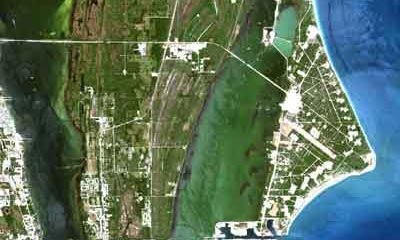|
|
 A view of the Cape Canaveral Spaceport from orbit. (credit: USGS) |
The necessity of launch range upgrades
by Winston W. Gardner, Jr.
Monday, December 8, 2003
The Air Force’s Eastern Range, extending from the Cape Canaveral Spaceport over the Atlantic and into space, is a complex system of equipment and people designed to ensure the safety of launches from the spaceport. The range has done its job with great success, but over the years has earned a reputation for excessive complexity and cost. Designed around the needs of mature, operational, largely government-supported launch programs (Atlas, Delta, Titan, Shuttle), the range is becoming too expensive and inflexible for new launch programs.
New programs now are actively looking at other launch sites besides the Eastern Range. Indeed, the “quick-reaction”, “operationally responsive” launch capability now desired for new military and commercial rockets is largely incompatible with the Eastern Range system. DOD’s new FALCON (Force Application and Launch from the Continental US) program, for example, seeks a capability for up to 16 launches within a 24-hour timeframe, while the Eastern Range advertises a minimum 48-hour turnaround between launches. Other programs, like DOD’s RASCAL (Responsive Access, Small Cargo, Affordable Launch) are also looking elsewhere for a launch site.
If not for the difficulty of bringing new programs onto the Eastern Range, we might see companies like Scaled Composites, KT Engineering, SpaceX, Microcosm, SpaceDev, and others beating a path to the Cape Canaveral Spaceport. Companies like Beal Aerospace could have been up and running by now with their low-cost launchers. This would create a competitive environment that would reduce costs for government and commercial users alike, but it is not happening. Instead we are seeing Atlas 5 and Delta 4 costs rise by up to 50%.
| If our launch ranges don’t like change, they will like irrelevance even less. |
The Air Force’s erstwhile program to upgrade its launch ranges has poured billions of dollars into incremental improvements for radar, optical and other tracking and telemetry equipment, all aimed at (to paraphrase a recent Air Force commander) replacing 1960s technologies with 1980s technologies… by 2010. While this program is currently in “strategic pause,” the federal government should re-think its approach to range upgrades.
NASA’s attention to spaceport and range technologies at Kennedy Space Center is a step in the right direction. The KSC-led Future Interagency Range and Spaceport Technology (FIRST) program, which includes the Air Force and FAA as partners, could be the incubator for technologies that will finally bring the Eastern Range, and our other national launch ranges, into the 21st century.
Advanced range technologies already available or under development will allow leapfrog improvements from the current radar-based range, to a highly responsive, lower-cost space-based range infrastructure. Some of these technologies are already being tested or used at other spaceports, or are commonly used elsewhere for missile launches, but the Eastern Range is somehow slow to adapt. The current slowdown in the commercial launch market has provided a convenient excuse for avoiding the requirement for range upgrades, but it should instead be viewed as the perfect opportunity to focus on such upgrades, to ensure that next-generation launch vehicles view the Cape as their preferred spaceport. To paraphrase another general: if our launch ranges don’t like change, they will like irrelevance even less.
Winston W. Gardner, Jr., is chairman of the Florida Space Business Roundtable.
|
|
